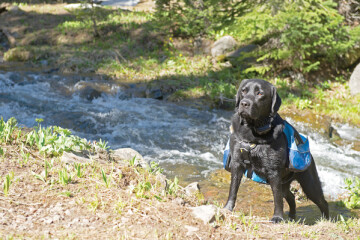Working Dogs for Conservation
Dogs abound. Most are pets, but some pull sleds, herd stock, support disabled persons, and do other tasks that help humans. Recently, I talked with Alice Whitelaw, Director of Programs and a founding member of Working Dogs for Conservation (WDC), about a new task for dogs – assisting scientists in conservation research.
WDC’s Beginnings
Animal conservation projects have normally involved getting biological samples from the animal being studied. Two of WDC’s founding members, both field biologists as well as dog enthusiasts, met doing fieldwork at a time when noninvasive techniques were slowly replacing commonly used methods involving animal contact. Whitelaw explains, “Not only are those methods dangerous, but they’re also very expensive. Researchers were discussing noninvasive techniques such as camera traps, hair snares and track plates. We started thinking about other noninvasive techniques and right about that same time good quality DNA was being extracted successfully from scat and we thought ‘what if…’”
WDC’s headquarters is in Montana, with teams in Bozeman, Missoula, Three Forks, and California. The program currently includes four founding members (Whitelaw, Aimee Hurt, Deborah Woollett, and Megan Parker), a handler, an executive director, and six active working dogs.
Projects
Most WDC projects involve locating the scat of a species and extracting DNA information. That information is then used by a variety of agencies (state and federal agencies in the United States, as well as other non-governmental agencies worldwide) to help make decisions about species management.
California corporation Topaz Solar Farms is building the largest solar farm in the world on land that is home to a large population of the endangered San Joaquin kit fox. WDC’s part in the project is to minimize the disruption to the foxes’ habitat. WDC’s involvement began well before construction started, and will continue for five years following completion. WDC dogs are trained to locate fox scat so that DNA can be extracted and individual foxes can be monitored. “On the site where there is construction there will be disruption of that particular bit of habitat, but there are mitigation lands set aside around that area that will provide enough space for the kit foxes to thrive,” Whitelaw explained.
“Prior to construction we went in with the dogs and did surveys for three years in a row during each fall and got a good baseline on what the population was doing and what individuals were there. It’s a really big project, and so it’s kind of fabulous to see what’s going on so far and be able to have all this information and see that the foxes at this point are thriving.”
Another project involved blunt-nosed leopard lizards. Without the dogs, lizards would be caught individually to get DNA samples. “The traditional monitoring method of looking for blunt-nosed leopard lizards is human visual surveys and is really time consuming. So far it’s looking like dogs are far more efficient and are finding lizards in places where they didn’t know they were,” Whitelaw said.
WDC will also be in Africa, involved in stopping the illegal use and trade of wild meat and animal parts. WDC’s work will benefit lions, elephants, wild dogs, and cheetahs. “We’ll be going in September to start an extensive dog program in Zambia and trying to facilitate having dogs on the ground there all the time to not only look for snares but to find bush meat and look for ivory in a variety of situations,” Whitelaw explained.
WDC also works with invasive species. “We just found out that we’ve got funding to work with the Montana Flathead Basin Commission to begin training dogs to detect invasive Zebra and Quagga mussels. We’re going to work with California Fish and Wildlife Department—they are the leaders in dog detection for finding mussels on watercraft and they’ve invited us to come spend time with them and train some of our veteran dogs to do pilot projects.”
WDC primarily uses rescue and shelter dogs for their program. “We find them in shelters or through rescue. We do have some dogs also that are career change dogs that have had the right drive but were not in the right job,” Whitelaw said. The dogs that WDC seeks are the ones that just aren’t cut out to be pets. They possess a certain “crazy” factor—uncontrolled energy, jumping up on everything, out of control—not dogs that make good family pets.
The breeds used are primarily German shepherds, Labrador retrievers, golden retrievers, border collies, Australian shepherds, and their crosses—dogs with natural focus and drive. Whitelaw emphasized that the breed of a potential candidate isn’t the most critical factor, though. “The individual characteristics are the most important thing,” she clarified.
There are several different levels of screening and training for new candidates. “We can’t make the dogs do the work. They have to love it. If they don’t have that drive and that love and that focus and the right kind of crazy, then they just simply can’t do the work.”
Potential candidates usually undergo a month and a half of evaluation and training before they can be considered as a strong candidate. Serious training doesn’t start until at least a year of age, but different breeds reach maturity at different times so it depends on the breed. “Probably one of the quickest dogs we’ve rescued and put to work was Aimee’s veteran dog, Wicket. She started training and was in the field within three weeks.” Wicket has since traveled all over the world and has worked on many different projects.
Training doesn’t start with basic obedience. During their preliminary training dogs are encouraged to maintain their enthusiasm and energy—that special kind of “crazy.” Obedience-trained dogs are too restrained for WDC’s training environment. Besides working on a reliable recall and sit, they aren’t expected to develop any of the other obedience behaviors. Once they learn what their job is, then obedience is incorporated.
If possible, targets are shipped to WDC to use in training. Initial training begins in Montana, and then continues in the field. Training begins in a controlled environment, perhaps a row of boxes with a jar in each—one of which contains the target. “When they get to the correct box, the ball appears from heaven and there’s a big party,” Whitelaw said. Then the dogs progress to less controlled scenarios, including the addition of wind, a larger search area, etc. There the dog learns to rely on the handler’s instructions more. “When they get to the target, they sit and then they look for us. We don’t let them touch anything.”
What is life like out in the field for the dogs? “Our dogs work continuously over months on one project and so we work three days on, then the dogs have a full day off, and then we work two days, followed by another full day off,” Whitelaw explained. “We’ve found over the years that duty cycle keeps them right where they need to be—they are as excited when they get out of the truck as they are when they get back.” During workdays, the dogs are performing work for approximately four hours each day. “We try and be pretty strict about that duty cycle in terms of the day off because not only do we get exhausted but we can see the dogs need their rest.”
The Handler/Dog Connection
During my conversation with Whitelaw, her description of the projects and the day-to-day work was fascinating, but what really caught my attention was the love and connection that she shares with her dogs. Several times during our talk, Whitelaw had tears in her eyes. I have seen this with other handlers/owners of working dogs as well; living and working together tends to add another level to the dedication and connection that they share. “I’ve never had dog relationships like I have with my working dogs. It’s taken it to a whole different place.”
She also has a profound respect for the work ethic of the dogs. Camas, one of Whitelaw’s dogs, was flown to California to work on a kit fox project. On the return flight, Whitelaw did not receive good communication from the flight staff when she asked for confirmation that Camas was on the airplane. When they arrived in Bozeman, Camas was not immediately found, and Whitelaw became frantic. Camas was indeed onboard, but was hidden behind some baggage.
Whitelaw describes the reunion: “The second I let her out of her crate to go potty (I was assuming she had to after the hours on the plane) she began to work again immediately. Not smelling around to find a potty place, but actually working.” With tears in her eyes Whitelaw reflects, “That is the kind of drive and resiliency that they have.”
For more information on Working Dogs for Conservation, visit their website at www.workingdogsforconservation.com


